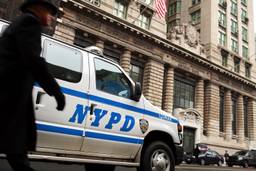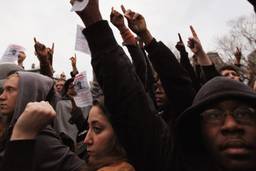It’s become something of a cliché to point out the fact that if police had treated the Tea Party protesters as they’re currently handling Occupy Wall Street demonstrators, the nation would have reacted somewhat differently to the crackdown.
For example, Glenn Beck would have clawed out his eyes on national television, screaming about all kinds of violations to the Constitution, and Congressional hearings would have run ‘round-the-clock on Fox News.
If I explained to you that not one, or two, but around seven (probably more) protesters have been mowed over by vehicles during protests, and the police let the drivers go without citations, you could probably easily guess during which protests those public safety lapses occurred. Of course, in some of these instances, OWS protesters were actually hit by police themselves, which explains, but does not excuse, why there weren’t immediate ramifications for those respective officers.
Ari Douglas, a National Lawyers Guild legal observer, was run over by a police motorcycle in October, and video recently emerged of an officer in Atlanta aggressively surging his motorcycle into a crowd, dangerously shoving protesters.
In D.C., a motorist struck three protesters simply because he “had a green light.” Police apparently agreed with that reasoning because the driver was permitted to leave the scene of the crime.
Meanwhile, in Oakland, where police gravely injured not one, but two Iraq veterans, more demonstrators were run over by vehicles without so much as a citation being handed out.
Lance Lavendure still wears hospital bracelets and walks with a cane after being hit by a Mercedes during Occupy Oakland’s general strike. In the video below, Lavendure can be seen banging on the hood of the car just before the vehicle jolts forward. Both Lavendure and his friend were injured during the incident, his friend’s ankle having been crushed by the car.
The driver of the Mercedes was not arrested and a spokesperson for Oakland police told ABC7 she “did not know” if the driver was cited.
A disturbing video emerged yesterday showing a protester filming a line of OPD officers moments before he’s shot with a rubber bullet. What’s alarming about the footage - other than the shooting itself, obviously - is how the cameraman repeatedly asks, “Is this okay?” to the officers, who don’t offer him a verbal warning, at least from what one can determine by the clip.
It goes without saying that by allowing disgruntled drivers to hit protesters and leave the scene the police are setting a dangerous precedent. There is little to stop anyone from mimicking this behavior if they’re annoyed they have to sit in traffic because of a protest, or they disagree with the political message of the marchers.
The public is always told the nation’s massive, and growing, police state is necessary in order to “protect” the public, and yet Occupy’s protests have shown that rather than existing to serve and protect, the police are used to stifle and crush First Amendment rights.
The violence demonstrated by a fraction of a fraction of the Occupy movement still pales in comparison to the brutal behavior demonstrated by police in the past month. Let’s remember that though the violence displayed by some police also puts them in a minority, those rogue officers are able to do a tremendous amount of physical damage to demonstrators whereas troublemaking protesters usually only damage property.
Police have hospitalized several protesters, in the case of Oakland’s two veterans, in critical condition. Kayvan Sabeghi managed to survive two tours of duty, but nearly suffered a fatal meeting with police in Oakland. Sabeghi says police repeatedly beat him with batons, and ultimately he had to have surgery in order to repair his damaged spleen.
In video shot by KTVU, Sabeghi at one point is standing alone, arms at his side, in front of a line of police. He appears to be speaking calmly, although the viewer cannot hear what he is saying. Sabeghi is wearing shorts, sandals and a dark, short-sleeved T-shirt. He is wearing a bandanna around his neck.
The next scene by KTVU shows Sabeghi after he has been taken to the ground, face down, by several officers. One appears to sit on his upper body while placing him in handcuffs or wrist restraints. The officers pull him to his feet, with a grimace of pain showing on Sabeghi’s face. As he stands there, Sabeghi says, “I am an Iraq War vet. I had two tours in Iraq, one tour in Afghanistan.”
In the case of the Sabeghi incident, as in the all of the examples listed above, there is a current investigation into what happened.
Of course, it should be clear to any rational bystander what’s occurring here. It’s obvious that by permitting drivers to leave the scene of the crimes after running over protesters and firing rubber bullets, among other projectiles, at activists that this was never about “public safety.”
The Occupy movements have directly threatened city officials’ leadership, and police are being used as tools to violently suppress the uprisings. “Public safety” is a convenient, but highly transparent, excuse to stampede the First Amendment rights of protesters.




